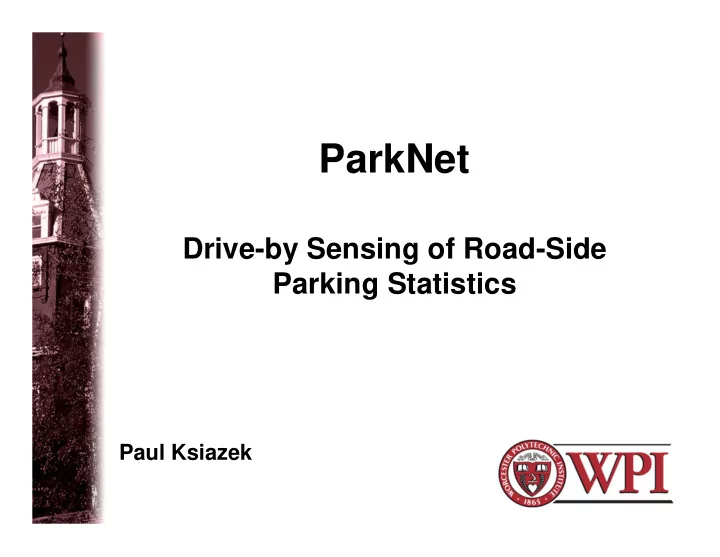

ParkNet Drive-by Sensing of Road-Side Parking Statistics Paul Ksiazek
What is ParkNet? • ParkNet is a mobile system comprising vehicles that collect parking space occupancy information while driving by. 2 Worcester Polytechnic Institute
Motivation • Challenging to obtain real-time street- parking availability statistics. • Traffic congestion is costly. – costs billions of dollars in the United States alone • Congestion and delays are largely due to parking. • No data available for roadside parking. 3 Worcester Polytechnic Institute
Usages • Improve traveler decisions – suggest parking spaces. • Dynamic parking space pricing – price changes based on slots available. • Assist parking enforcement 4 Worcester Polytechnic Institute
Setup Each car gathering data has the following: • Ultrasonic Sensor – distance to car – availability increasing – potential for reuse • PS3 webcam – evaluation, analysis and training • GPS – coordinates of car • Computer, power adapter, and wiring – compute and transmit data 5 Worcester Polytechnic Institute
Setup • The system is installed into vehicles which regularly move about the city. – taxi cabs (used in this paper) – public buses – police cars • Easier to install and users don’t have to worry about setting it up themselves. 6 Worcester Polytechnic Institute
Slotted vs. Unslotted • Slotted • Unslotted – fixed size – depends on vehicle length – one car per slot – fire hydrants, no parking 7 Worcester Polytechnic Institute
Goals • Determine parking availability on an hourly basis. • Helpful to parking enforcement. • Low-cost. • Low vehicle participation. 8 Worcester Polytechnic Institute
Slotted Algorithm Width: distance from the start to the end of a dip. Depth: how far from the baseline a dip extends. • Remove dips with too few readings. – can be caused by going too fast • Training – get ideal threshold values – 19 separate test trips – optimal error rate of 12.4% • Depth threshold • Width threshold – width greater than 2 thresholds counts as 2 cars. • Vacant Spaces = total slots – counted cars 9 Worcester Polytechnic Institute
Unslotted Algorithm • Measure space between parked cars. • See how many cars can fit in that space. – 6 meters per car • Available spots = distance / fixed size (6 meters) 10 Worcester Polytechnic Institute
Evaluation • Used webcam pictures to evaluate accuracy. – False positives: trees, pedestrians, bikes. – Misdetection: car is there but not detected. • 95% accuracy for parking space counts. • 90% accuracy for occupancy maps. 11 Worcester Polytechnic Institute
GPS Inaccuracy • Accuracy for occupancy map must be higher than space count. • GPS inaccuracy can cause spots to be mismatched. • Used environmental fingerprinting to increase accuracy. – fixed objects are location-tagged using the video stills. – street needs to be traced multiple times so fingerprinting takes more effort. • Position corrected using the Hungarian algorithm. – graph optimization algorithm. 12 Worcester Polytechnic Institute
GPS Inaccuracy 13 Worcester Polytechnic Institute
Mobility and Scalability • Tracked mobility patterns of 536 taxis in San Francisco over a month. • Greater San Francisco area – mean time between visits in hundreds of minutes. • Downtown – mean time less than 10 minutes. • Most parking is in areas with many taxis. 14 Worcester Polytechnic Institute
ParkNet vs Fixed Parking Fixed Parking: monitor each slotted parking space individually. • SFPark – 6000 parking spaces – currently being employed in San Francisco 15 Worcester Polytechnic Institute
Cost • ~$400 for each sensing vehicle. – $250-$800 for the smart parking system • ~$120,000 for a given area in San Francisco. – $1.5 million for the smart parking system. • One vehicle can cover multiple parking spots. – Need a sensor for each fixed parking spot. 16 Worcester Polytechnic Institute
Maintenance • ParkNet is easy to maintain, – can be maintained when taxis go in for maintenance. – cities offer many free WiFi spots. • Each fixed parking spot must be maintained separately. 17 Worcester Polytechnic Institute
Disadvantages • Parking spot is not guaranteed to be up to date. – fixed parking sensors are always up to date. • Greater coverage, but random. 18 Worcester Polytechnic Institute
Unresolved Issues • Multilane Roads – only tested on single lane roads. – car driving next to sensing vehicle. • Speed Limitations – high speed leads to misdetections. – parking areas usually have lower speed limits. • Obtaining maps – time-dependent spots – manual construction from satellite pictures – possible to automatically generate 19 Worcester Polytechnic Institute
Related Works • Parking garages with counters. – not displayed on the internet. • Airports and train stations • Buying and selling parking spaces. • Reserved parking spaces. • Pothole detection. 20 Worcester Polytechnic Institute
Results and Contributions • Their prototype was a success in obtaining real-time street-parking statistics. – Accurate – Low Cost – Scalable – Useful • Useful even with a slight error rate. – don’t need to know exact number of available slots. 21 Worcester Polytechnic Institute
Future Work • Use the webcam as part of the system. – computer vision algorithms can help detect cars. – solution to lane detection? – give users images of the parking spaces. • Prediction base on statistics. – data gathered over time can be used to predict parking space availability in the future. – useful for long-term planning. 22 Worcester Polytechnic Institute
Recommend
More recommend